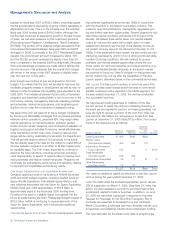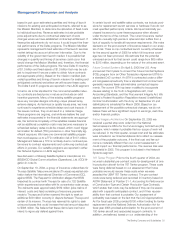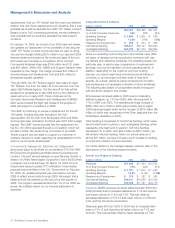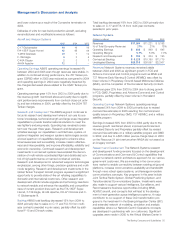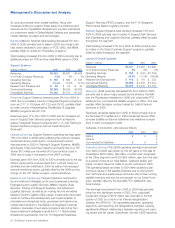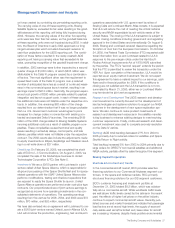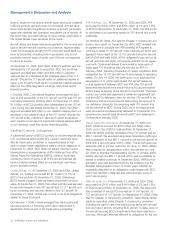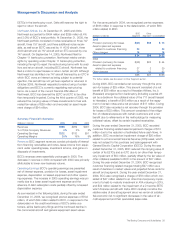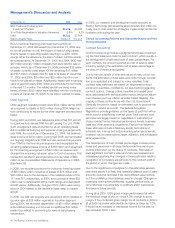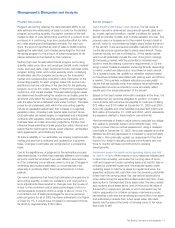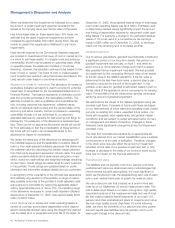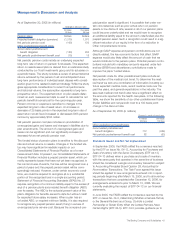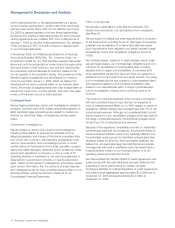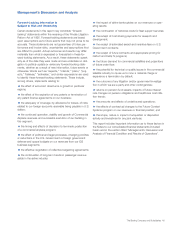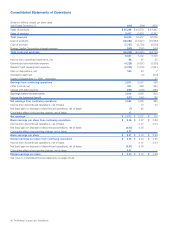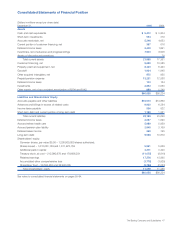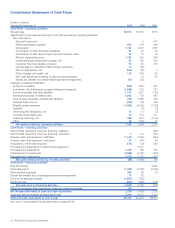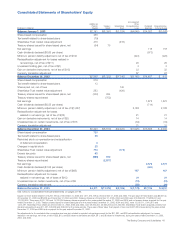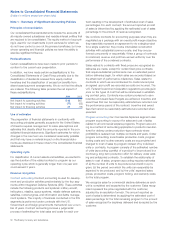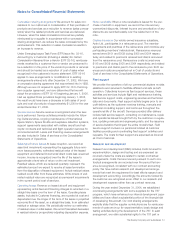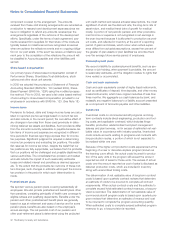Boeing 2005 Annual Report Download - page 44
Download and view the complete annual report
Please find page 44 of the 2005 Boeing annual report below. You can navigate through the pages in the report by either clicking on the pages listed below, or by using the keyword search tool below to find specific information within the annual report.Management’s Discussion and Analysis
When we determine that impairment is indicated for an asset,
the amount of asset impairment expense recorded is the
excess of the carrying value over the fair value of the asset.
Had future lease rates on these assets been 10% lower, we
estimate that the asset impairment expense would have
increased by approximately $46 million during 2005. We are
unable to predict the magnitude or likelihood of any future
impairments.
Used aircraft acquired by the Commercial Airplanes segment
are included in Inventories at the lower of cost or market as it is
our intent to sell these assets. To mitigate costs and enhance
marketability, aircraft may be placed on operating lease. While
on operating lease, the assets are included in ‘Customer
financing’, however, the valuation continues to be based on the
lower of cost or market. The lower of cost or market assess-
ment is performed quarterly using the process described in the
Used aircraft under trade-in commitments section.
Allowance for losses on receivables The allowance for losses on
receivables (valuation provision) is used to provide for potential
impairment of receivables on the Consolidated Statements of
Financial Position. The balance represents an estimate of prob-
able but unconfirmed losses in the receivables portfolio. The
estimate is based on various qualitative and quantitative fac-
tors, including historical loss experience, collateral values,
results of individual credit reviews and the general state of the
economy and airline industry. Factors considered in assessing
collectibility include, but are not limited to, a customer’s
extended delinquency, requests for restructuring and filings for
bankruptcy. The adequacy of the allowance is assessed quar-
terly. There can be no assurance that actual results will not dif-
fer from estimates or that the consideration of these factors in
the future will not result in an increase/decrease to the
allowance for losses on receivables.
We review the adequacy of the allowance by assessing both
the collateral exposure and the applicable cumulative default
rate (i.e. the credit-adjusted collateral exposure). We determine
the collateral value by calculating the median values obtained
from third-party equipment appraisers’ industry data. The appli-
cable cumulative default rate is determined using two compo-
nents: customer credit ratings and weighted-average remaining
contract term. Credit ratings are determined for each customer
in the portfolio. Those ratings are updated based on public
information and information obtained directly from our customers.
In recognition of the uncertainty of the ultimate loss experience
and relatively long duration of the portfolio, a range of reason-
ably possible outcomes of the portfolio’s credit-adjusted collat-
eral exposure is calculated by varying the applicable default
rate by approximately plus or minus 15%. The resulting range
of the allowance necessary to cover credit-adjusted collateral
exposure as of December 31, 2005, was approximately $240
million to $307 million.
Lease Residual Values Equipment under operating leases is
carried at cost less accumulated depreciation and is depreci-
ated to estimated residual value using the straight-line method
over the lease term or projected economic life of the asset. At
December 31, 2005, the projected residual value of total equip-
ment under operating leases was $2.6 billion. Estimates used
in determining residual values significantly impact the amount
and timing of depreciation expense for equipment under oper-
ating leases. For example, a change in the estimated residual
values of 1% could result in a cumulative pre-tax earnings
impact of $26 million as of December 31, 2005, to be recog-
nized over the remaining term of the lease portfolio.
Goodwill impairment
Due to various acquisitions, goodwill has historically constituted
a significant portion of our long-term assets. We perform our
goodwill impairment test annually, on April 1, and when an
event occurs or circumstances change such that it is reason-
ably possible that an impairment may exist. We test goodwill
for impairment by first comparing the book value of net assets
to the fair value of the related operations. If the fair value is
determined to be less than book value, a second step is per-
formed to compute the amount of the impairment. In this
process, a fair value for goodwill is estimated, based in part on
the fair value of the operations, and is compared to its carrying
value. The shortfall of the fair value below carrying value repre-
sents the amount of goodwill impairment.
We estimate the fair values of the related operations using dis-
counted cash flows. Forecasts of future cash flows are based
on our best estimate of future sales and operating costs, based
primarily on existing firm orders, expected future orders, con-
tracts with suppliers, labor agreements, and general market
conditions, and are subject to review and approval by our sen-
ior management and Board of Directors. Changes in these
forecasts could significantly change the amount of impairment
recorded, if any.
The cash flow forecasts are adjusted by an appropriate dis-
count rate derived from our market capitalization plus a suitable
control premium at the date of evaluation. Therefore, changes
in the stock price may also affect the amount of impairment
recorded. At the date of our previous impairment test, a 10%
increase or decrease in the value of our common stock would
have had no impact on the financial statements.
Postretirement plans
The liabilities and net periodic cost of our pension and other
postretirement plans are determined using methodologies that
involve several actuarial assumptions, the most significant of
which are the discount rate, the expected long-term rate of asset
return, and medical trend (rate of growth for medical costs).
We use a discount rate that is based on a point-in-time esti-
mate as of our September 30 annual measurement date. This
rate is determined based on a review of long-term, high quality
corporate bonds as of the measurement date and use of mod-
els that match projected benefit payments of our major U.S.
pension and other postretirement plans to coupons and maturi-
ties from high quality bonds. (See Note 17) In the following
table, we show the sensitivity of our pension and other postre-
tirement benefit plan liabilities and net periodic cost to a 25
basis point change in the discount rate.
42 The Boeing Company and Subsidiaries


